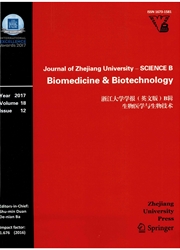

 中文摘要:
中文摘要:
Interleukin-5 (IL-5 ) 通过嗜曙红血球的激活伴随航线发炎和 hyperresponsiveness 的发展。因此,在肺织物的 IL-5 表示的干扰似乎是在气喘治疗的一条接受途径。在这研究,我们设计了小介入 RNA (siRNA ) 禁止 IL-5 的表示。对 IL-5 的 siRNAs 在表示系统,和 1.5 × 1 的 lentivirus 被构造 0 6 IFU (形成包括的单位) lentiviruses 予敏化的 ovalbumin (卵) intratracheally 被以鼠科的气喘的模型。我们的结果证明对 IL-5 的交付 lentivirus 的 siRNA 高效地禁止了 IL-5 信使核糖核酸(mRNA ) 表示并且显著地在肺织物稀释了发炎。嗜曙红血球和煽动性的房间的重要减少在外部血, bronchoalveolar 洗室年龄液体(BALF ) ,和肺织物被发现。另外,航线 hyperresponsiveness (AHR ) 的重要抑制在对 IL-5 与 siRNA 对待的老鼠被发现。这些观察证明借助于 lentivirus 系统交付的 siRNA 是可能为气喘的一条有效治疗学的途径。
 英文摘要:
英文摘要:
Interleukin-5 (IL-5) accompanies the development of airway inflammation and hyperresponsiveness through the activation of eosinophils. Therefore, interference of IL-5 expression in lung tissue seems to be an accepted approach in asthma therapy. In this study, we designed a small interfering RNA (siRNA) to inhibit the expression of IL-5. The siRNAs against IL-5 were constructed in a lentivirus expressing system, and 1.5×10^6 IFU (inclusion-forming unit) lentiviruses were administered intratracheally to ovalbumin (OVA)-sensitized murine asthmatic models. Our results show that lentivirus-delivered siRNA against IL-5 efficiently inhibited the IL-5 messenger ribonucleic acid (mRNA) expression and significantly attenuated the inflammation in lung tissue. Significant decrease of eosinophils and inflammatory cells were found in peripheral blood, bronchoalveolar lavage fluid (BALF), and lung tissue. In addition, significant inhibition of airway hyperresponsiveness (AHR) was found in the mice treated with siRNA against IL-5. These observations demonstrate that siRNA delivered by means of the lentivirus system is possibly an efficacious therapeutic approach for asthma.
 同期刊论文项目
同期刊论文项目
 同项目期刊论文
同项目期刊论文
 A fusion protein containing murine vascular endothelial growth factor and tissue factor induces thro
A fusion protein containing murine vascular endothelial growth factor and tissue factor induces thro Antisense interleukin-5 reduces eosinophil infiltration and hyperresponsiveness in an allergic asthm
Antisense interleukin-5 reduces eosinophil infiltration and hyperresponsiveness in an allergic asthm Combination of recombinant xenogeneic endoglin DNA and protein vaccination enhances anti-tumor effec
Combination of recombinant xenogeneic endoglin DNA and protein vaccination enhances anti-tumor effec 期刊信息
期刊信息
